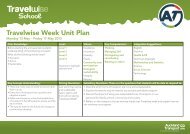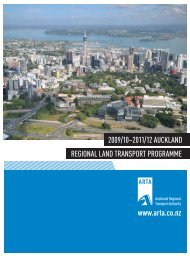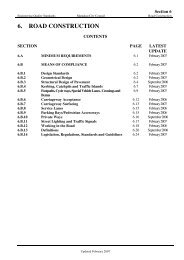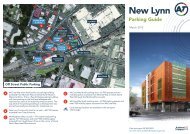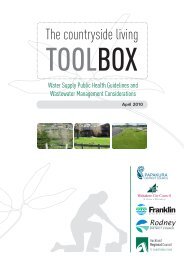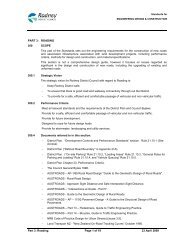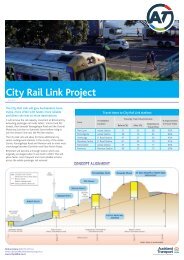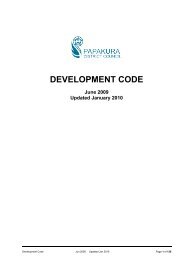Auckland Transport Statement of Intent 2012 - 2015
Auckland Transport Statement of Intent 2012 - 2015
Auckland Transport Statement of Intent 2012 - 2015
You also want an ePaper? Increase the reach of your titles
YUMPU automatically turns print PDFs into web optimized ePapers that Google loves.
(f) Derivative financial instruments<br />
<strong>Auckland</strong> <strong>Transport</strong> uses derivative financial instruments to hedge exposure to foreign exchange. In<br />
accordance with its treasury policy, <strong>Auckland</strong> <strong>Transport</strong> does not hold or issue derivative financial<br />
instruments for trading purposes.<br />
The fair value <strong>of</strong> financial instruments traded in active markets is based on quoted market prices at the<br />
year-end date. The quoted market price used for financial assets held by <strong>Auckland</strong> <strong>Transport</strong> is the<br />
current bid price. The quoted market price for financial liabilities is the current ask price.<br />
The fair values <strong>of</strong> forward foreign exchange contracts are determined using a discounted cash flows<br />
valuation technique based on quoted market prices. The inputs into the valuation model are from<br />
independently sourced market parameters such as currency rates.<br />
Derivatives are initially recognised at fair value on the date a derivative contract is entered into and are<br />
subsequently remeasured at their fair value. The resulting gain or loss is recognised immediately in<br />
surplus/(deficit) within „other gains(losses) unless the derivative instrument has been designated as a<br />
hedging instrument and qualifies for hedge accounting, in which case, the method <strong>of</strong> recognising the<br />
resulting gain or loss is discussed below.<br />
Derivatives that qualify for hedge accounting<br />
When a derivative is designated as a hedging instrument, <strong>Auckland</strong> <strong>Transport</strong> documents a hedge<br />
relationship as either a cash flow hedge (hedge <strong>of</strong> a forecast transaction) or a fair value hedge (hedge <strong>of</strong><br />
the fair value <strong>of</strong> a recognised asset or liability). Also documented are the nature <strong>of</strong> the risk being hedged,<br />
its risk-management objective, strategy for hedge transactions, identification <strong>of</strong> the hedging instrument<br />
and hedged item, and how the hedging instrument„s effectiveness is to be assessed.<br />
Cash flow hedge<br />
The effective portion <strong>of</strong> changes in the fair value <strong>of</strong> derivatives that are designated and qualify as cash<br />
flow hedges is recognised in equity in the hedging reserve. The gain or loss relating to the ineffective<br />
portion is recorded in the statement <strong>of</strong> comprehensive income.<br />
When a hedging instrument expires, or is sold or terminated, or when a hedge no longer meets<br />
accounting criteria, any cumulative gain or loss in equity at that time remains in equity and is recognised<br />
when the forecast transaction is recorded in the statement <strong>of</strong> comprehensive income. When a forecast<br />
transaction is no longer expected to occur, the cumulative gain or loss reported in equity transfers to the<br />
statement <strong>of</strong> comprehensive income.<br />
Fair value hedge<br />
<strong>Auckland</strong> <strong>Transport</strong> only applies fair value hedge accounting for hedging fixed interest risk on<br />
borrowings. The gain or loss relating to the effective portion <strong>of</strong> the interest rate swaps that hedge fixedrate<br />
borrowings is recognised in the statement <strong>of</strong> comprehensive income within “finance costs”. The gain<br />
or loss relating to the ineffective portion is recognised in the statement <strong>of</strong> comprehensive income within<br />
"other gains/ (losses)”. Changes in the fair value <strong>of</strong> the hedged fixed-rate borrowings attributable to<br />
interest rate risk are recognised in the statement <strong>of</strong> comprehensive income within “finance costs”.<br />
If the hedge no longer meets the criteria for hedge accounting, the adjustment to the carrying amount <strong>of</strong><br />
a hedged item for which the effective interest method is used is recorded in the statement <strong>of</strong><br />
comprehensive income.<br />
(g) Inventories<br />
Inventories such as spare parts, stores and finished goods are stated at lower <strong>of</strong> cost and net realisable<br />
value. Cost comprises direct materials, direct labour and an appropriate proportion <strong>of</strong> variable and fixed<br />
overhead expenditure, the latter being allocated on the basis <strong>of</strong> normal operating capacity.<br />
37



